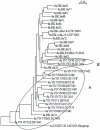A possible geographic origin of endemic hepatitis C virus 6a in Hong Kong: evidences for the association with Vietnamese immigration
- PMID: 21931867
- PMCID: PMC3172306
- DOI: 10.1371/journal.pone.0024889
A possible geographic origin of endemic hepatitis C virus 6a in Hong Kong: evidences for the association with Vietnamese immigration
Abstract
Background: Hepatitis C virus (HCV) 6a accounts for 23.6% of all HCV infections of the general population and 58.5% of intravenous drug users in Hong Kong. However, the geographical origin of this highly predominant HCV subgenotype is largely unknown. This study explores a hypothesis for one possible transmission route of HCV 6a to Hong Kong.
Methods: NS5A sequences derived from 26 HCV 6a samples were chosen from a five year period (1999-2004) from epidemiologically unrelated patients from Hong Kong. Partial-NS5A sequences (513-bp from nt 6728 to 7240) were adopted for Bayesian coalescent analysis to reconstruct the evolutionary history of HCV infections in Hong Kong using the BEAST v1.3 program. A rooted phylogenetic tree was drawn for these sequences by alignment with reference Vietnamese sequences. Demographic data were accessed from "The Statistic Yearbooks of Hong Kong".
Results: Bayesian coalescent analysis showed that the rapid increase in 6a infections, which had increased more than 90-fold in Hong Kong from 1986 to 1994 correlated to two peaks of Vietnamese immigration to Hong Kong from 1978 to 1997. The second peak, which occurred from 1987 through 1997, overlapped with the rapid increase of HCV 6a occurrence in Hong Kong. Phylogenetic analyses have further revealed that HCV 6a strains from Vietnam may be ancestral to Hong Kong counterparts.
Conclusions: The high predominance of HCV 6a infections in Hong Kong was possibly associated with Vietnamese immigration during 1987-1997.
Conflict of interest statement
Figures


References
-
- Naoumov NV, Chokshi S, Metivier E, Maertens G, Johnson PJ, et al. Hepatitis C virus infection in the development of hepatocellular carcinoma in cirrhosis. J Hepatol. 1997;27:331–336. - PubMed
-
- Simmonds P, Bukh J, Combet C, Deleage G, Enomoto N, et al. Consensus proposals for a unified system of nomenclature of Hepatitis C Virus genotypes. Hepatology. 2005;42:1–12. - PubMed
-
- Pawlotsky JM, Tsakiris L, Roudot-Thoraval F, Pellet C, Stuyver L, et al. Relationship between hepatitis C virus genotypes and sources of infection in patients with chronic hepatitis C. J Infect Dis. 1995;171:1607–1610. - PubMed
-
- Wong DA, Tong LK, Lim W. High prevalence of hepatitis C virus genotype 6 among certain risk groups in Hong Kong. Eur J Epidemiol. 1998;14:421–426. - PubMed
Publication types
MeSH terms
LinkOut - more resources
Full Text Sources
Medical
Research Materials

